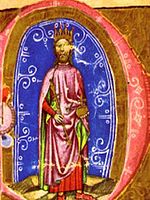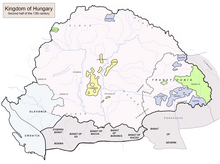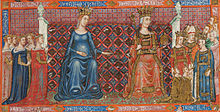Stephen V of Hungary
Stephen V (Hungarian: V. István, Croatian: Stjepan V., Slovak: Štefan V.; before 18 October 1239 – 6 August 1272) was King of Hungary and Croatia between 1270 and 1272, and Duke of Styria from 1258 to 1260.
Still a child, Stephen married Elizabeth, a daughter of a chieftain of the Cumans whom his father settled in the Great Hungarian Plain.
Stephen forced his father to cede all the lands of the Kingdom of Hungary to the east of the Danube to him and adopted the title of junior king in 1262.
Stephen was the eighth child and first son of King Béla IV of Hungary and his wife, Maria, a daughter of Theodore I Lascaris, Emperor of Nicaea.
[5] Béla and his family, including Stephen, fled to Zagreb after the Mongols had annihilated the royal army in the Battle of Mohi on 11 April 1241.
[6] The Mongols crossed the frozen Danube in February 1242 and the royal family ran off as far as the well-fortified Dalmatian town of Trogir.
[5] Apparently, in the previous year, Béla had his son crowned as junior king and endowed with the lands between the river Dráva and the Adriatic Sea, according to historians Gyula Kristó and Ferenc Makk.
[25] The Peace of Vienna, which was signed on 31 March 1261, put an end to the conflict between Hungary and Bohemia, forcing Béla IV to renounce of Styria in favor of Ottokar II.
[27] On the other hand, Stephen's charters prove that he made land grants in Bihar, Szatmár, Ugocsa, and other counties which were situated outside Transylvania.
[28] Archbishops Philip of Esztergom and Smaragd of Kalocsa undertook to mediate after some clashes occurred between the two kings' partisans in the autumn.
[29][30] According to the Peace of Pressburg, which was concluded around 25 November, Béla IV and his son divided the country and Stephen received the lands to the east of the Danube.
[31][32] When confirming the treaty on 5 December, Stephen also promised that he would not invade Slavonia which had been granted to his younger brother, Béla, by their father.
[29][31] A Bulgarian nobleman, Despot Jacob Svetoslav sought assistance from Stephen after his domains, which were situated in the regions south of Vidin, were overrun by Byzantine troops in the second half of 1263.
[36] Stephen confiscated the domains of his mother and sister, Anna—including Beszterce (present-day Bistrița, Romania) and Füzér—which were located in the lands under his rule.
[31][37] King Béla's Judge royal, Lawrence arrived at the head of a new army and forced Stephen to retreat to Feketehalom (now Codlea, Romania).
[36][42] During the civil war in Hungary, Stephen's vassal, Despot Jacob Svetoslav submitted himself to Tsar Constantine Tikh of Bulgaria.
[20][48] Henry Kőszegi, Nicholas Geregye, and Lawrence Aba—Béla's closest advisors—followed her and handed over Kőszeg, Borostyánkő (Bernstein, Austria) and their other castles along the western borders to Ottokar II.
[20][49] Instead of leaving Hungary, Nicholas Hahót garrisoned Styrian soldiers in his fort at Pölöske, and made plundering raids against the nearby villages.
[50] Stephen nominated his own partisans to the highest offices; for instance, Joachim Gutkeled became Ban of Slavonia, and Matthew Csák was appointed Voivode of Transylvania.
[49][52] Stephen also met Ottokar II on an island of the Danube near Pressburg (present-day Bratislava, Slovakia), but they only concluded a truce.
[54] He also confirmed the liberties of the Saxon "guests" in the Szepesség region (present-day Spiš, Slovakia), contributing to the development of their autonomous community.
[56] On the other hand, Stephen protected the Archbishop of Esztergom's rights against the conditional nobles of the archbishopric who attempted to get rid of their obligations.
[54] Ban Joachim Gutkeled kidnapped Stephen's ten-year-old son and heir, Ladislaus and imprisoned him in the castle of Koprivnica in the summer of 1272.
[65] Stephen's third (or fourth) daughter, Elizabeth, who was born in about 1260, became a Dominican nun in the Monastery of the Blessed Virgin on Rabbits' Island.







